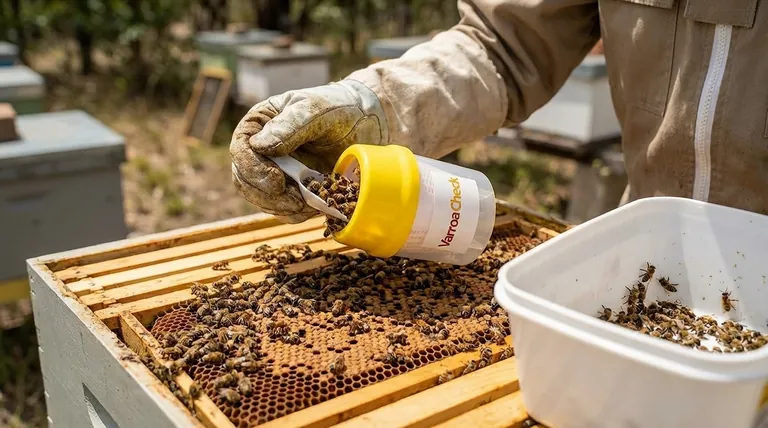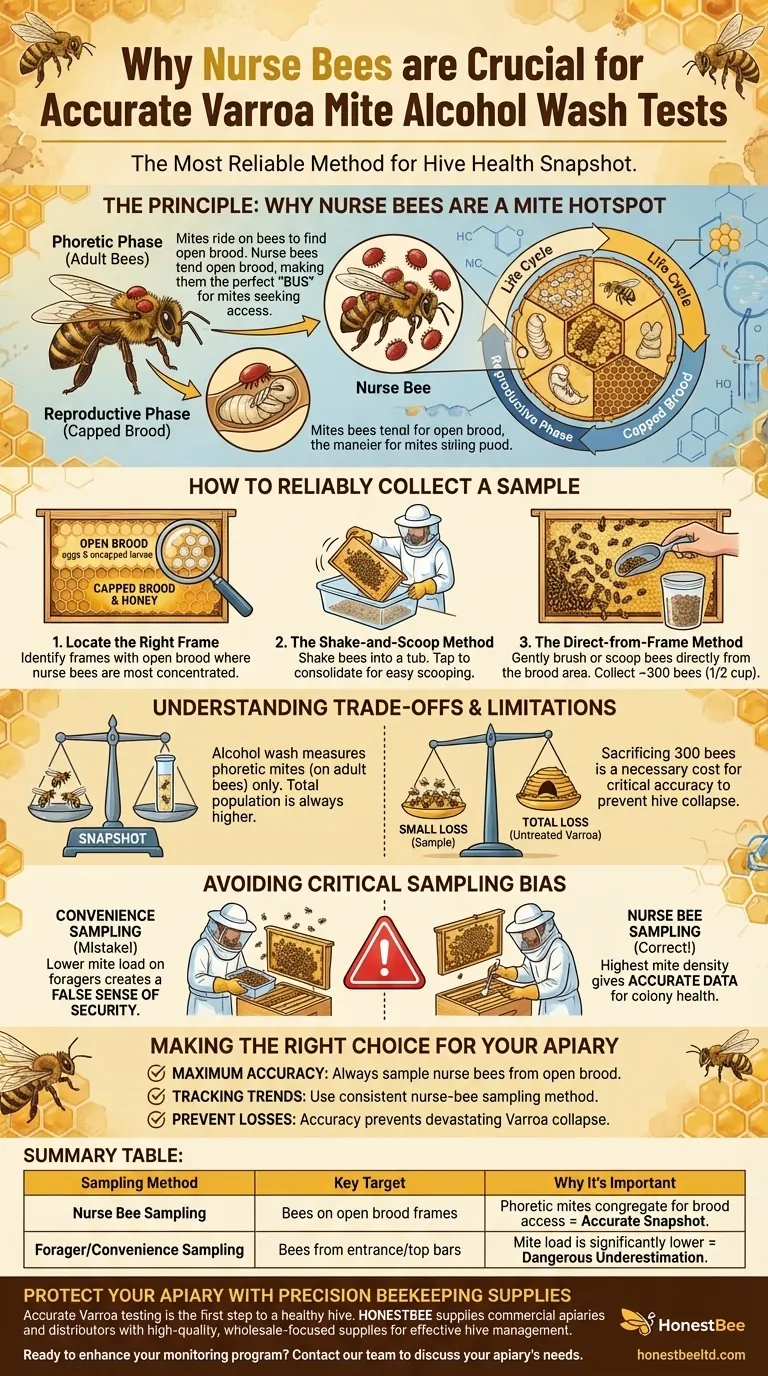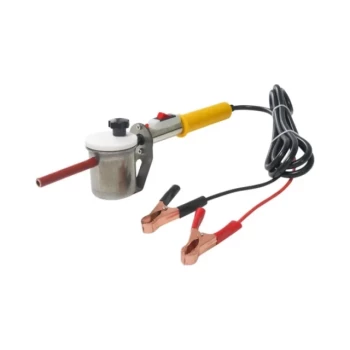Selecting nurse bees for a Varroa mite alcohol wash is the most reliable way to get an accurate test result. These bees, found tending to uncapped larvae, have the highest concentration of phoretic-stage mites in the colony. Because Varroa mites gather on nurse bees to gain access to brood cells for reproduction, sampling this specific population ensures your test reflects the true mite pressure within the hive.
The goal of Varroa testing is not just to count mites, but to create a reliable snapshot of the hive's infestation level. Focusing on nurse bees provides this reliability because their behavior makes them a natural gathering point for the very mites you need to measure.

The Principle: Why Nurse Bees Are a Mite Hotspot
Mite Behavior Drives the Method
The Varroa mite life cycle has two primary phases: a reproductive phase inside a capped brood cell and a phoretic phase where mites ride on adult bees.
During the phoretic phase, a mite's sole objective is to find a new, mature larva cell to enter just before it is capped.
Nurse Bees as the Ideal Vehicle
Nurse bees are the workers responsible for feeding and tending to open brood. They are constantly moving in and out of the exact cells that mites need to infest.
This behavior makes them the perfect "bus" for mites seeking a ride into a brood cell. Consequently, phoretic mites congregate on nurse bees far more than on foragers or other adult bees.
The Impact on Your Sample
By exclusively sampling nurse bees, you are testing the bee population with the highest density of phoretic mites.
This gives you the most accurate data possible for the colony's overall phoretic mite load. A sample of forager bees from the entrance would dangerously underestimate the infestation level, potentially leading to a delayed or missed treatment decision.
How to Reliably Collect a Nurse Bee Sample
Locate the Right Frame
The first step is to identify a frame containing open brood, meaning eggs and uncapped larvae. This is where nurse bees are most concentrated.
Avoid frames that contain only honey, pollen, or capped brood, as you will not find a high enough concentration of your target bees.
The Shake-and-Scoop Method
A common and effective technique is to shake the entire frame of bees into a plastic tub. The quick shake dislodges most bees.
Once in the tub, gently tap it to consolidate the bees into one corner, making it easy to scoop a sample.
The Direct-from-Frame Method
Alternatively, you can hold the frame over your collection tub or basket and gently brush or scoop bees directly from the brood area.
Continue until you have collected approximately a half-cup of bees, which is the standard sample size of roughly 300 bees.
Understanding the Trade-offs and Limitations
It's a Snapshot, Not the Whole Picture
An alcohol wash only measures phoretic mites—those currently on adult bees. It does not count the mites reproducing under capped brood.
The total mite population in the hive is always higher than what your alcohol wash indicates. However, this method provides a standardized index for making treatment decisions.
The Necessary Cost of Accuracy
The primary trade-off of an alcohol wash is the sacrifice of approximately 300 bees.
While this is a cost, the highly accurate data it provides is critical for protecting the entire colony from a potentially devastating Varroa collapse. It is a small loss to prevent a total one.
Avoiding Critical Sampling Bias
The biggest mistake is collecting a "convenient" sample of bees from the top bars, inner cover, or hive entrance.
These bees are not nurse bees and will have a much lower mite load. Using them for your sample will create a false sense of security and lead to inaccurate, unreliable data.
Making the Right Choice for Your Apiary
A reliable Varroa monitoring program is the cornerstone of responsible beekeeping. Understanding the principles behind the method is as important as performing the test itself.
- If your primary focus is maximum accuracy for treatment decisions: Always sample nurse bees directly from a frame containing open brood.
- If you are tracking infestation levels over time: Consistency is key; using the same nurse-bee sampling method every time provides the most reliable data for trend analysis.
- If you are concerned about sacrificing bees: Remember that the accuracy gained from an alcohol wash on nurse bees prevents the much larger colony losses caused by untreated Varroa infestations.
By understanding and targeting the specific bee population where Varroa mites congregate, you transform a simple count into a powerful diagnostic tool for hive health.
Summary Table:
| Sampling Method | Key Target | Why It's Important |
|---|---|---|
| Nurse Bee Sampling | Bees on open brood frames | Phoretic mites congregate on nurse bees for brood access, providing the most accurate infestation snapshot. |
| Forager/Convenience Sampling | Bees from hive entrance or top bars | Mite load is significantly lower, leading to dangerous underestimation of colony threat. |
Protect Your Apiary with Precision Beekeeping Supplies
Accurate Varroa mite testing is the first step to a healthy hive. The right equipment makes the process efficient and reliable.
HONESTBEE supplies commercial apiaries and beekeeping equipment distributors with the high-quality, wholesale-focused supplies needed for effective hive management. From durable sampling kits to essential protective gear, we provide the tools for success.
Ready to enhance your monitoring program with professional-grade equipment? Contact our team today to discuss your apiary's needs and explore our product catalog.
Visual Guide

Related Products
- Varroa Easy Check Mite Tester Kit Counter Alcohol Wash Jar
- 12V Bee Mite Removal Evaporator Oxalic Acid Vaporizer for Bee Fumigation Treatment 180W Atomization
- Professional Plastic Queen Excluder for Modern Beekeeping
- Nicot Queen Rearing Kit for Beekeeping and Grafting in Nicot System
- Langstroth Screen Bottom Board for Beekeeping Wholesale
People Also Ask
- What is the Varroa EasyCheck used for? Accurate Mite Monitoring for Healthy Hives
- What is the most accurate method for monitoring varroa mites? The Definitive Guide for Beekeepers
- How often should varroa mite checks be performed using the alcohol wash method? Optimize Your Apiary's Health
- What is the most reliable method for assessing Varroa mite infestations? Master Proactive Hive Management
- What are the steps to perform an alcohol wash test after collecting the bees? A Guide to Accurate Varroa Mite Counting



















